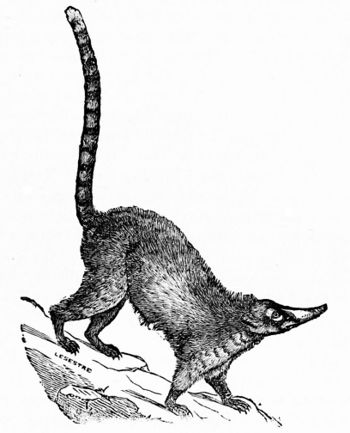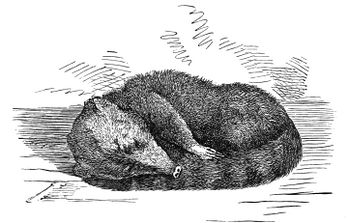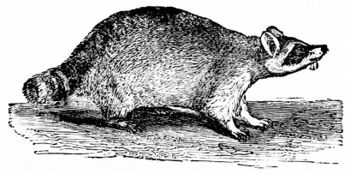Popular Science Monthly/Volume 2/December 1872/The Coati-Mondi and its Cousins
SAILORS from South America occasionally, among other pets, bring a small animal, which, because of its long nose, they invariably call an Ant-eater. Thus was a little stranger introduced to our care a few years ago. A glance was enough to see that it was no ant-eater at all, but a pretty female Coati-Mondi. Gallant Jack Tar, her master on ship, unconscious of the incongruity, had made a namesake of her and called her Jack. Science had already named her Nasua, and in a matter-of-fact way, for the word interpreted just means—Nosie. The animal was about the size of a cat, with a thick, coarse fur, of a brownish hue on the back and sides, and underneath shades from yellow to orange. The long tail was ornamented by a series of black and yellowish-brown rings. Her nasal prominence reminded me of a queer Spaniard, once employed in the government service to detect spurious coin. His "counterfeit detector" was a sensitive proboscis. By sticking this organ into the glittering heaps he literally "nosed" out the bad from the good. To that man his nose was the instrument of his profession; and to Nasua her nose was equally important. It even prompted a nick-name and a juvenile pun—"Nosie's nose knows too much!" Inappeasably inquisitive, she was incessantly intruding that organ into every thing. Having made no allowance for an extra-tropical temperature, this little South American made a failure in an attempt to lift with her nose the lid of a pot in the cook's domain. The next attempt, a successful one, was on the knife-box, whose closely-fitting lid was pried open, and every article inspected, in happy ignorance of the proverb about edged tools. It was enough that any thing was hollow to excite her curiosity, which was of a thoroughly simian type. The dinner-bell was turned over; but, unable to detach the clapper and chain, it was soon abandoned in disgust. A round sleigh-bell received more persevering attention. Unable to get her nose or paws into the little hole at the side, the clatter within set her wild with excitement, and evoked a desperate attack on the little annoyance with her teeth. She then gave it up as a bootless job. A bottle of hartshorn was next made the subject of investigation. We had purposely loosened the cork, and promised ourselves a "nice sell" and we got it—not Nosie. She was not in the least disconcerted by the drug. In fact, she had a strong nose for such things. A man gave her his tobacco-box. Resting it on the floor between her two paws, which possessed uncommon flexibility, she turned it over and over, round and round, exercising alternately her nose, claws, and teeth upon it with great energy, but to no avail. It seemed that the smell of its contents infatuated her, as she showed no disposition to
 [137]
stop. The man opened the box for her. She was in rapture. In went the nose, also both front paws. Very soon that wonderfully mobile organ had separated every fibre, so that the mass seemed trebly increased. The same man let her have his dirty pipe, when her velvety nose was instantly squeezed into the rank nicotian bowl.
[137]
stop. The man opened the box for her. She was in rapture. In went the nose, also both front paws. Very soon that wonderfully mobile organ had separated every fibre, so that the mass seemed trebly increased. The same man let her have his dirty pipe, when her velvety nose was instantly squeezed into the rank nicotian bowl.
It would be wrong to infer that Nasua's prying propensity never got her into trouble. In the following instance, speaking metaphorically, she put her foot into it: The old cat had just finished her nap, and was stretching herself, an operation which means that she stood with her four feet close together, the limbs elongated, the back rounded up like that of a camel, the head erect and drawn back, and the mouth yawning widely. Such a sight Nosie had never seen, hence it must
Fig. 1.
Coati-Mondi (Nasua fusca) A native of South America. The full-grown animal is about the size of the domestic cat. Compare its bear-like step with Fig. 4.
be looked into. So in a trice, erect, and resting flatly on her hind-feet like a little bear, she put her arms round Tabbie's neck, and, reeking with nicotine, down went that inquisitive nose into the depths of the feline fauces. This unwarrantable intrusion was met by a reception more feeling than felicitous, judging from the haste in which Nasua withdrew to a corner of the room to ruminate on the untoward incident. Her method of relieving the injured member was itself original. She placed it between her paws, holding it tightly, then jerked it through them, giving a violent sneeze every time it came out. That
 [138]
sneezing was genuine, because it was involuntary. Both hartshorn and nicotine had signally failed to get up any thing respectable in that line; but that cat-nip, pure and simple, did the business finely.
[138]
sneezing was genuine, because it was involuntary. Both hartshorn and nicotine had signally failed to get up any thing respectable in that line; but that cat-nip, pure and simple, did the business finely.
Quite pretty was the pattern of the animal's ears—they were so clean, trim, soft, and small. Though rather pert, they had an air about them that was really amiable, and such as the canine fancier would pronounce elegant. She was not averse to a little fondling, and I well remember the first time she climbed upon my lap. Those pretty ears suddenly quivered. The ticking of my watch had excited her. Down goes that ubiquitous utilitarian organ into the watch-pocket. Failing with the nose, she makes a desperate effort with that and both fore-feet all at once. Still unable to evict that case of mystery, she thrusts her nose down by its side, and for several minutes, with simian quaintness, listens to the ticking of mortal Time.
Fig. 2.
Coati-Mondi asleep. (Original) Compare the snout with those of the three pachyderms, Figs. 5, 6, and 7. It agrees functionally, and, in the main, structurally, with that of the Swine Fig. 6, and with that of the Peccary. Fig. 5. The Peccary snout, too, approaches it in flexibility. But the Tapir, Fig. 7, surpasses it in this particular. In the cut, which is excessively foreshortened, the sleeping animal is using its tail as a cushion for the head.
On the above occasion Coati was allowed the liberty often taken by the little dog, of going to sleep on my lap, while I gave myself up to the enjoyment of my book. Her nap finished, I did not notice when she left my lap. Soon a noise was heard like the tearing of paper. The wonderful little beast had abstracted my pocket-diary, and in violation of all propriety was making heavy extracts in a litter-ary way. Those keen incisors were scissoring away—a full leaf at a time! She had even filched a five-dollar note out of the pouch of the book, and, by way of change, had converted it into fractional currency.
In the same manner, though not to the same extent, the nose of the Nasua, like the same organ of the elephant, projects far beyond the mouth. At our first acquaintance with the animal, we were anxious to see if it could drink out of a deep, narrow vessel. So a mug, containing about a gill of milk, was set before her. She instantly turned up the proboscis toward her forehead, and, in the easiest way imaginable, lapped the vessel dry. The organ was not even wet. The sight, though comical, was really pretty. It was the only time that I had ever seen the turning up of the nose at one's friends so deftly and gracefully done. And she could turn the same organ in a contrary way quite as easily. The first time she confronted a mirror, startled at beholding her own counterfeit presentment, instantly her countenance fell—very low indeed; for her nose bent downward, and actually curved under the chin. Of course the word chin is not here anatomically correct. Her proboscis now looked like that of a tapir in repose. This singular grimace, with its squeaky little grunts, presented a very funny manifestation of surprise.
Fig. 3.
Raccoon (Procyon lotor). A near ally of the Coati-Mondi, having the same plantigrade, or bear-like step, and certain other resemblances of form and habit. The tail is too short in the cut, which is due to the foreshortening.
Sometimes for an airing the animal was tied by a long tether to a flower-stand on the lawn. It should have been mentioned that she was literally omnivorous. She would catch a mouse and eat it all up. The heads of poultry given her in the kitchen would be eaten ravenously. The same is true of sweetmeats, which she occasionally got by stealth. She would drink every thing, not even stopping at brandy. She had nearly all the Template:SIC of the domestic swine; and the end of her proboscis was essentially a swine's snout. I now beheld the use of this singularly-tipped organ. And an interesting sight it was to see that little thing plough up the greensward with the tip of her nose—and so easily. Here appeared the veritable swinish acuteness of scent for insects and worms, and the swinish facility for rooting in the ground. With surprising rapidity furrow after furrow was made, of about the width of a man's thumb. Whenever a worm or insect was discovered, as when drinking, the nose was curved up, so that the mouth could extract the object from the furrow.
See also
- Sources




